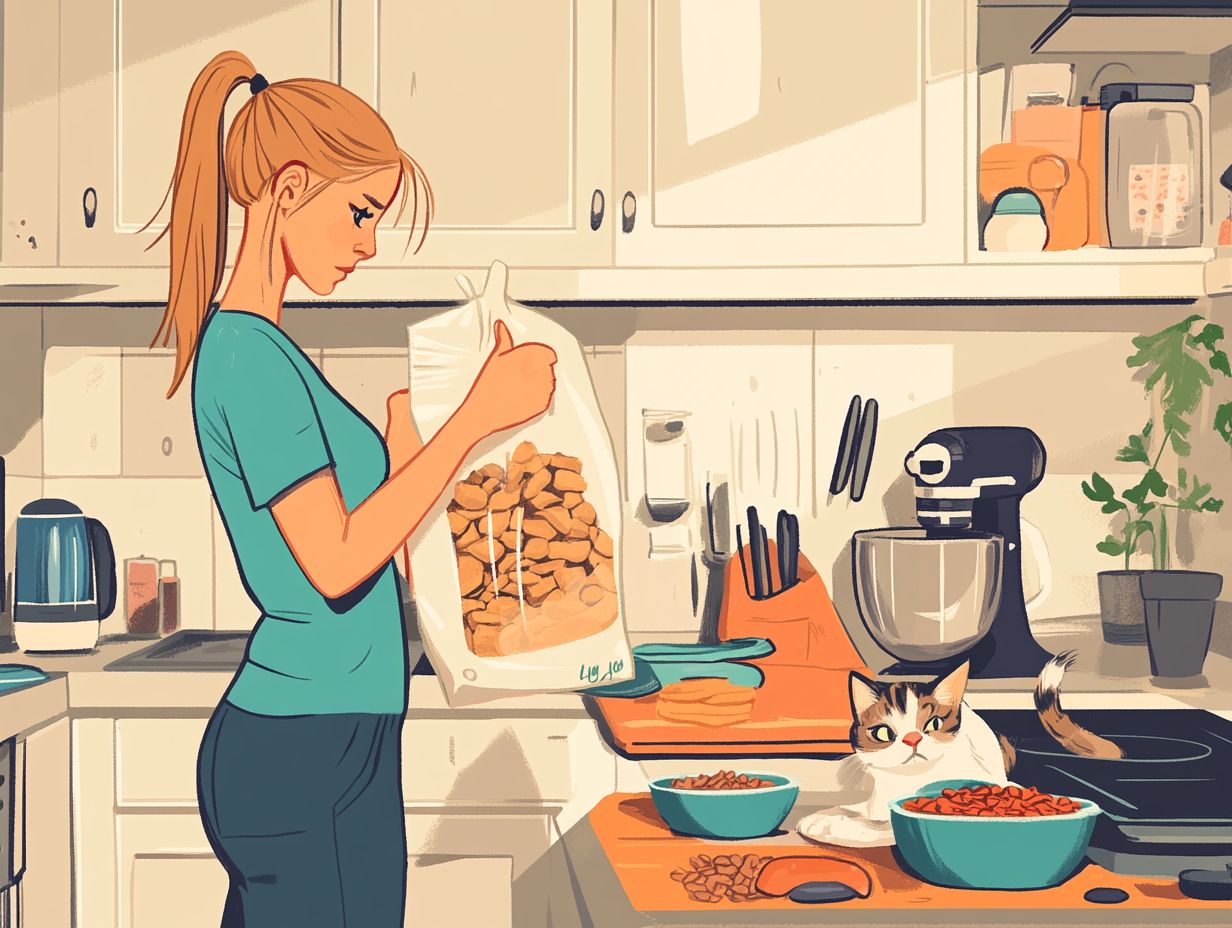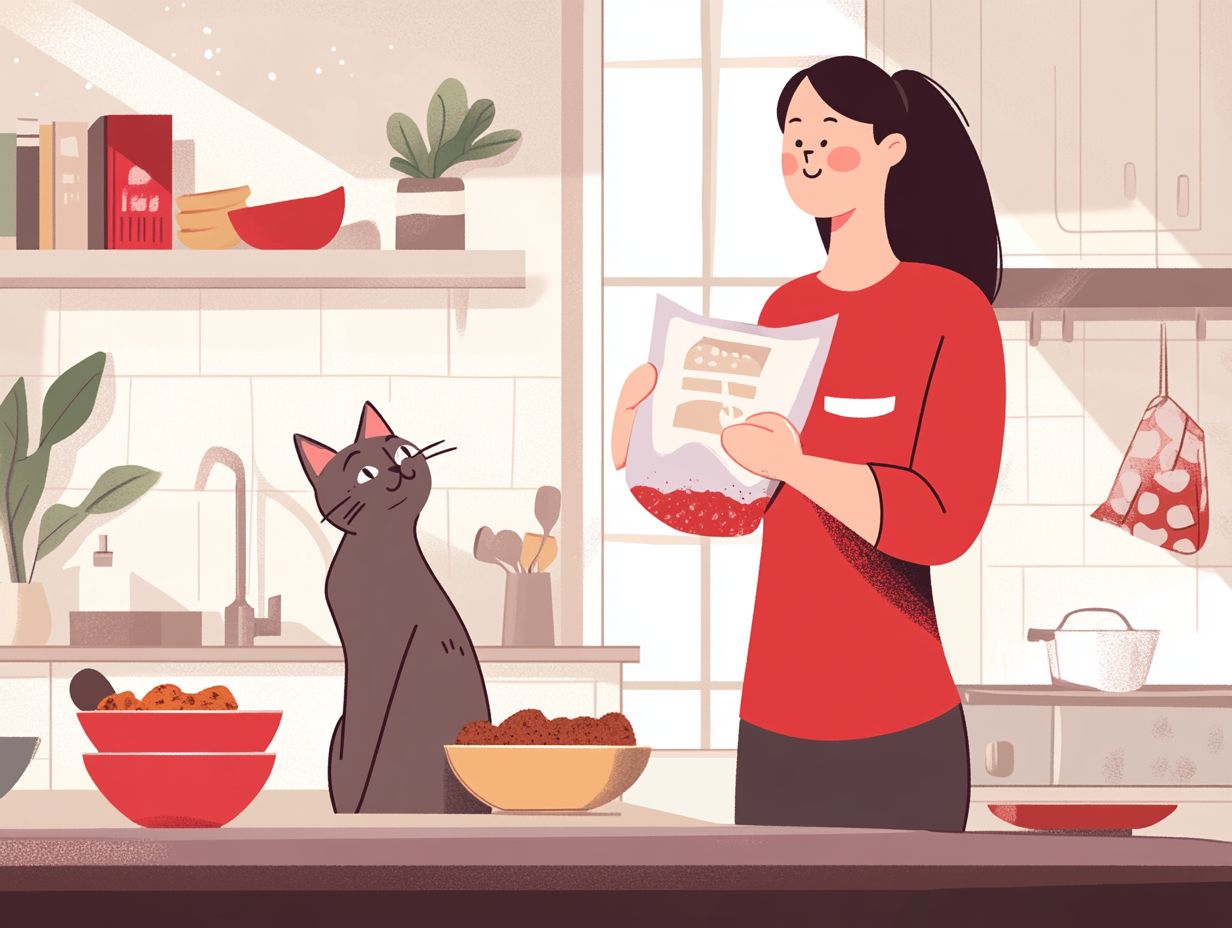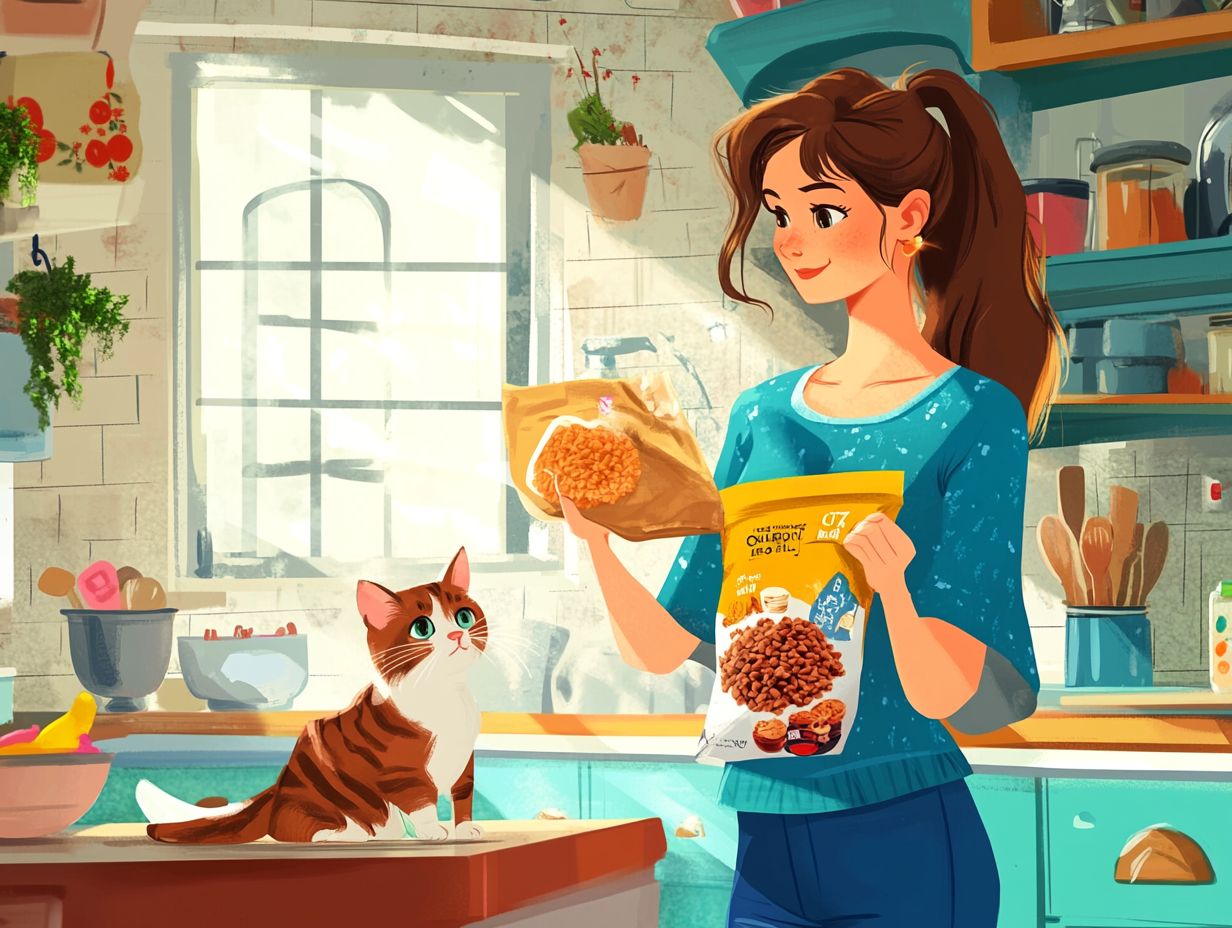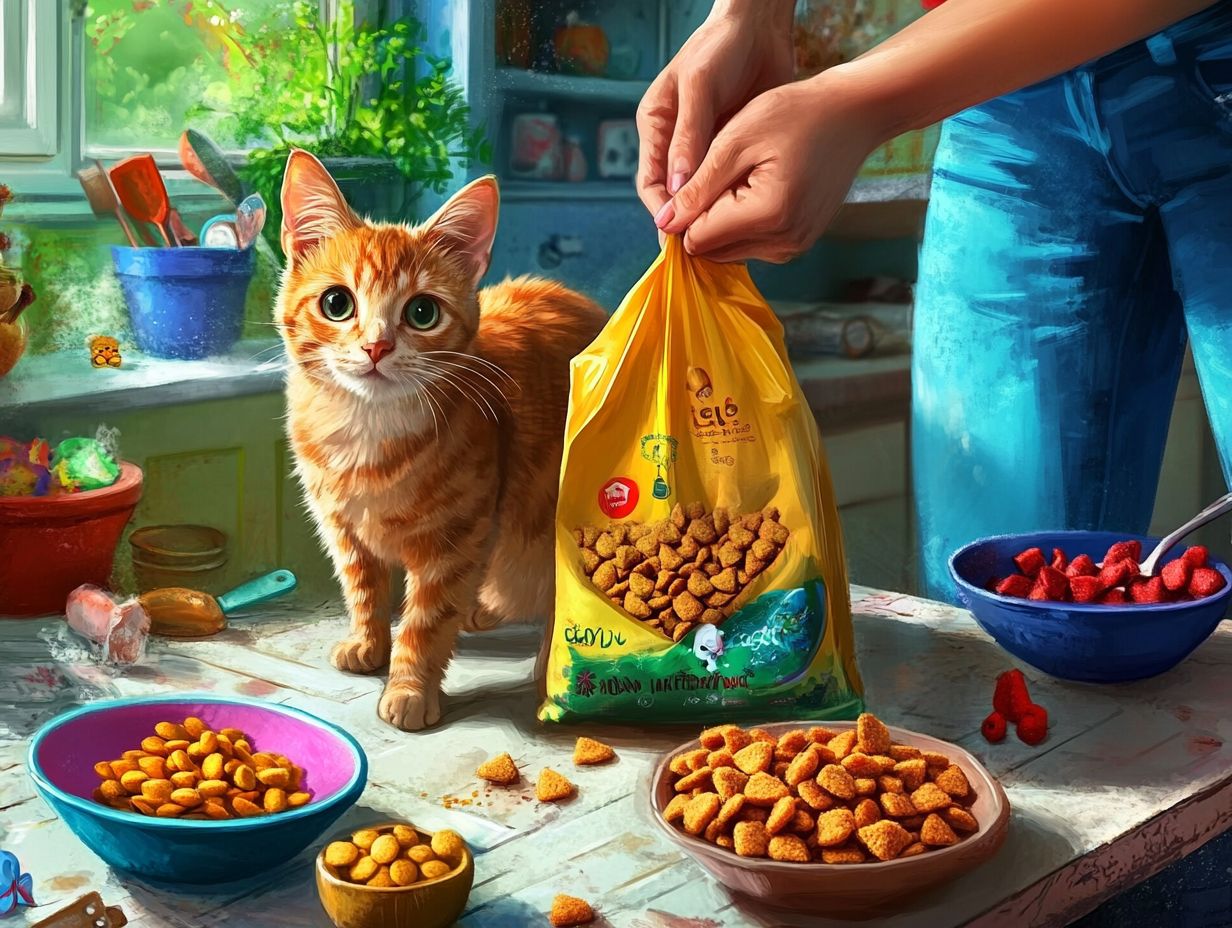If you’re a cat parent exploring nutritious options, freeze-dried cat food and other commercial raw diets might have caught your attention. However, it’s crucial to consult with a veterinarian or a veterinary nutritionist before making significant dietary changes, particularly when considering raw or freeze-dried diets.
This food type promises to preserve the essential nutrients found in fresh ingredients while offering convenience and ease of storage, making it a popular choice among pet parents. However, potential risks associated with freeze-dried and raw diets, such as bacterial contamination and nutritional imbalances, must be carefully considered. Emphasizing proper handling and storage practices is essential.
As with any pet food, concerns arise regarding safety, particularly around raw meat, potential bacterial contamination, and nutritional imbalances. This article explores what freeze-dried cat food is, how it’s made, its benefits, and addresses common safety concerns, including food safety guidelines, to help you make informed choices for your feline friend.
Key Takeaways:

- Freeze-dried cat food retains nutritional value and is convenient for storage and traveling.
- Concerns about safety, cost, and nutritional deficiencies can be addressed by choosing reputable brands, proper handling and storage, consulting with a veterinary nutritionist, and considering alternatives.
- Freeze-dried cat food is safe for your feline friend when handled properly and from trusted sources.
What Is Freeze-Dried Cat Food?
Freeze-dried cat food is an innovative option that merges the benefits of raw cat food with the convenience and safety of modern preservation methods. The freeze-drying process removes moisture while retaining essential nutritional value, resulting in a shelf-stable food that can help prevent nutritional deficiencies in cats. Cats are obligate carnivores, so it is vital that their diets prioritize animal-source proteins to meet their essential amino acid requirements.
This type of food is crafted from high-quality nutrition and premium ingredients, ensuring that cats receive a complete and balanced diet. Often considered human-grade, this term refers to the quality of the ingredients and not the appropriateness of the food for human consumption, reflecting high quality and safety standards.
How Is Freeze-Dried Cat Food Made?
The process of creating freeze-dried cat food employs advanced food preservation methods that ensure maximum nutrient retention while adhering to stringent food safety standards. It begins with the preparation of raw meat and other fresh ingredients, which must meet the specific quality criteria set by pet food manufacturers.
The freeze-drying process utilizes moisture removal techniques, such as vacuum sealing, to extract water from the food. This process helps prevent bacterial contamination and extends the product’s shelf life.
Ingredients are sourced solely from suppliers that have been independently certified to comply with rigorous animal welfare and sustainability standards. High-quality proteins and fresh vegetables are procured from reputable suppliers who meet these standards.
Once gathered, these ingredients are rapidly frozen to form ice crystals that preserve their cellular structure.
In a vacuum environment, sublimation occurs, allowing ice to transform directly into vapor without converting to liquid. This method is particularly effective in maintaining the food’s integrity and flavor. The final product is extremely lightweight, boasts a long shelf life, and retains essential nutrients.
What Are the Benefits of Freeze-Dried Cat Food?
The advantages of freeze-dried cat food are numerous, contributing to its rapid rise in popularity among cat owners seeking to provide their pets with a high-quality diet without the complexities associated with raw cat food. The benefits of freeze-dried cat food include:
- Nutritional Value: Freeze-drying preserves the nutritional integrity of the ingredients, ensuring a rich source of protein and other essential nutrients for felines. It is important to select formulations that cater to the specific health needs of cats, such as those with kidney disease or diabetes.
- Shelf Stability: Freeze-dried foods are shelf-stable, meaning they do not require refrigeration, and their long shelf life makes them convenient for traveling pet owners or those who prefer to feed their cats smaller portions at a time.
- Ease of Preparation: Freeze-dried food can be easily rehydrated by adding water, and it can also be served dry for cats that enjoy crunchy textures. This flexibility allows owners to prepare the food in various ways without compromising their cats’ digestive system.
1. Retains Nutritional Value
The primary benefit of freeze-dried cat food is the preservation of its nutritional value, ensuring that cats receive a complete and balanced diet rich in essential nutrients. The freeze-drying process minimizes nutrient loss and maintains the quality of the premium and human-grade ingredients used in the formulation. While freeze-dried food can be part of a cat’s diet, it should not be the sole source of nutrition without careful planning to ensure a balanced diet.
When preparing freeze-dried food, pet owners should follow specific food safety tips, such as safely rehydrating the food and adhering to storage instructions to prevent spoilage. Ideal storage conditions include cool, dry places with low humidity, and signs of spoilage can include an off smell or unusual texture.
Additionally, it is essential for freeze-dried cat food products to meet AAFCO (Association of American Feed Control Officials) standards, and pet owners should look for this certification when choosing products.
This method effectively retains vitamins, minerals, and proteins, all of which are crucial for feline health. By choosing freeze-dried options, pet owners can proactively reduce the risk of nutritional deficiencies and other health risks, as supported by recent veterinary guidelines. For instance, studies indicate that freeze-dried food can help maintain improved digestion and increased energy levels.
A diet rich in these nutrients contributes to specific health benefits, such as better skin condition and enhanced vitality. Providing nutritious food can significantly improve a cat’s overall well-being.
2. Convenient and Easy to Store
Freeze-dried cat food offers a long shelf life of up to 24 months, is easy to store, and is both lightweight and compact, making it convenient for busy pet parents. Its shelf-stable nature allows for long-term storage without refrigeration and eliminates the need for complex food storage guidelines, in accordance with AAFCO standards.
The lightweight and compact packaging enhances storage convenience, taking up minimal space in cabinets and making organization straightforward, whether at home or in travel bags.
Additionally, feeding is simple; it requires only the addition of water to rehydrate the food, typically at a ratio of 1:4 (food to water). This ease of use promotes a hygienic food safety environment, allowing owners to maintain cleanliness whether at home or on the go.
These time-saving features also help ensure a consistent diet for cats by removing the need for measuring and mixing.
3. Ideal for Traveling and Active Lifestyles

For pet parents who frequently travel with their cats, freeze-dried cat food is an excellent option that offers the convenience of easy transport alongside high-quality nutrition. Its compact packaging and lightweight nature ensure that cats can meet their full nutritional needs on the road while minimizing the risk of foodborne illnesses.
This type of food is simple to prepare, requiring only the addition of water, which makes feeding even more manageable in new environments. Additionally, safety during travel is enhanced, as freeze-dried foods have longer shelf lives of up to 24 months and are less affected by temperature fluctuations, making them ideal pet treats.
Freeze-dried cat food also allows owners to cater to their pets’ specific dietary requirements, which is particularly important for cats with food sensitivities. Pet owners should consult their veterinarians about dietary changes when traveling, emphasizing the importance of professional guidance for a smooth transition.
4. Great for Picky Eaters
Freeze-dried cat food offers several advantages, particularly in its ability to be easily incorporated into gourmet meals, making it a great option for picky eaters. The variety of flavors and high-quality nutrition found in these products often attract even the most finicky cats.
Additionally, the texture and taste of freeze-dried options serve as an excellent alternative to traditional raw cat food, especially for those concerned about food allergies. Beyond flavor, freeze-dried cat food provides a wider selection of choices that cater to specific dietary needs, addressing concerns for cats sensitive to certain ingredients.
Veterinary nutritionists frequently recommend these products, as they promote a balanced approach to feline nutrition, facilitating proper weight maintenance and overall well-being. However, pet owners should gradually introduce new food to prevent gastrointestinal upset, following veterinary recommendations for transitioning diets. By choosing freeze-dried cat food, pet owners can offer their companions gourmet meals while minimizing the risks associated with food allergies.
What Are the Concerns about Freeze-Dried Cat Food and Raw Food Diets?
Freeze-dried cat food offers numerous advantages; however, pet parents should also consider some legitimate concerns, particularly regarding safety and health risks such as bacterial contamination, nutritional consultation, and food handling safety associated with raw meat.
The potential for bacterial contamination, including pathogens such as E. coli, Salmonella, and Listeria, raises serious veterinary concerns. Therefore, adhering to food safety guidelines, such as washing hands and surfaces, keeping raw foods separate, and consulting with veterinary associations like the AVMA and AAFCO is essential to minimize the risk of foodborne illness.
1. Safety of Raw Meat
The primary concern with freeze-dried cat food is the potential for nutritional deficiencies and other health issues, including tuberculosis, associated with the raw meat used to make it. Improper handling of raw meat can pose health risks for cats and dogs. It is vital to ensure a balanced diet by integrating freeze-dried food into a complete nutritional plan and monitoring cats’ responses to any new diet, including identifying potential allergies or intolerances.
Therefore, consulting with a veterinary nutritionist can help pet owners navigate these challenges. Veterinary nutritionists play a crucial role in assessing the quality and sourcing of ingredients in freeze-dried options, often involving guides like the ACVN and FDA standards, to ensure they meet cats’ dietary needs. Personalized dietary plans based on individual cat health and conditions are essential for optimizing nutrition.
They can assist in creating balanced meal formulations and identifying deficiencies that may arise from solely feeding raw meat, such as taurine deficiency or unbalanced calcium-to-phosphorus ratios. Additionally, their focus on safe processing and storage practices can help minimize health risks, such as bacterial contamination involving Clostridium, and support the overall health of cats.
2. Potential for Bacterial Contamination
Bacterial contamination poses a significant concern with freeze-dried cat food, as pathogens like E. Coli and Salmonella can pose serious risks to both cats and humans. It is essential for pet owners to follow food safety guidelines to minimize the likelihood of foodborne illness.
To protect their feline companions and themselves, caregivers should prioritize proper handling and storage practices. Proper handling includes thawing frozen food safely and avoiding cross-contamination by using separate utensils for serving. Storing food in a cool, dry place with specific temperature ranges (ideally below 70°F) can help prevent bacterial growth, and washing hands before and after handling pet food is crucial for maintaining hygiene and adhering to pet food safety guidelines.
Additionally, checking expiration dates and selecting reputable brands with stringent safety standards can further mitigate risks, such as foodborne illness. By implementing these food safety practices, pet owners can create a safer feeding environment, ultimately enhancing the well-being of their beloved cats.
3. Cost
The price of freeze-dried cat food can be a drawback for some pet parents, as it often exceeds that of commercial pet food options due to the high quality, premium ingredients, and organic components used in its formulation. However, the nutritional value may justify the higher cost.
When comparing different options, pet owners should also consider the health benefits that superior nutrition can provide for their cats, such as improved digestion, shinier coats, and increased energy. These advantages can lead to fewer veterinary visits and a longer, healthier life, ultimately saving money in the long run by reducing risks of nutritional deficiencies.
Cheaper options may lack these essential nutrients and could lead to health issues down the line. For any pet owner caring for their cats, it is crucial to weigh the pros and cons of price versus quality.
How to Address These Concerns?

Concerns regarding freeze-dried cat food can be addressed to ensure the safety and health of your cat by selecting a reliable brand. This entails choosing a freeze-dried cat food brand known for its strong track record in delivering a complete and balanced diet and adhering to safety standards.
1. Choose a Reputable Brand
Choosing a reputable freeze-dried cat food brand is essential for ensuring high quality and safety standards. Key factors to consider include endorsements from veterinary associations, the use of high-quality ingredients sourced from well-known pet food manufacturers, and compliance with important certifications such as the AAFCO (Association of American Feed Control Officials) nutrition standards.
The best freeze-dried cat food brands will offer a clear and transparent ingredient list, allowing pet owners to understand what they are feeding their cats. Additionally, brands that receive endorsements or testimonials from pet nutritionists can provide extra assurance regarding the product’s safety and effectiveness, helping cat owners make informed choices they can trust.
2. Follow Proper Handling and Storage Guidelines
To maximize the benefits and safety of freeze-dried cat food, proper handling and storage are essential. Adhering to food safety practices helps maintain the product’s intended benefits and extends its shelf life. It’s important to store the food in a cool, dry place with low humidity levels (ideally below 50%) and to regularly check for any spoilage signs, such as off odors or discoloration.
3. Consider Special Nutritional Needs
Cats at different life stages, such as kittens, seniors, and pregnant or nursing cats, have unique nutritional needs. Consulting a veterinary nutritionist can help tailor freeze-dried options to address these needs effectively. Additionally, cats with conditions like diabetes or kidney disease may require specific nutrient profiles, which can be achieved with the right freeze-dried formulations.
Lastly, if any supplements are recommended in conjunction with freeze-dried diets, ensure to follow proper dosages and safety guidelines to optimize your cat’s health.
It is crucial to store freeze-dried cat food in a cool, dry place, away from direct sunlight. When transferring the food to another container, use a clean, dry, airtight container to prevent exposure to moisture or pests. Additionally, always use a clean, dry utensil to scoop out the food to avoid contamination. Regularly check the sealed packaging for any rips, tears, or signs of spoilage, which could indicate bacterial contamination. Spoilage can include changes in texture, odor, or color. When stored properly, freeze-dried cat food can last for [insert typical duration here] but should be discarded if any signs of spoilage are detected.
By following these simple precautions, you can ensure that your cat enjoys fresh food with a longer shelf life, consumed safely. Furthermore, regularly evaluate your cat’s weight and adjust dietary choices according to updated feline obesity guidelines.
3. Consult with a Veterinarian
Yes, consulting with veterinarians or veterinary nutritionists is essential to assess the suitability of freeze-dried cat food for your pet’s nutritional needs, particularly for cats with specific health concerns such as kidney disease or diabetes. These nutritional consultations can address specific health issues and dietary histories.
Through personalized consultations, veterinarians can help identify the most appropriate brands, formulations, and types of food for your cat. Their expertise in feline nutrition, combined with knowledge of your cat’s lifestyle, age, and pre-existing conditions, ensures tailored recommendations for optimal health and addresses veterinary concerns. It is particularly important to ensure that animal-source proteins are included in the diet, as cats are obligate carnivores.
For example, nutrient profiles that are crucial for different life stages include higher protein and fat levels for kittens, balanced nutrition for adults, and lower protein levels for senior cats, while pregnant or nursing cats require increased caloric intake and essential nutrients during these critical periods.
4. Consider Alternatives
Pet owners who are concerned about the safety or cost of freeze-dried cat food can opt for commercially produced raw diets or other forms of raw food alternatives. These options can offer similar nutritional value and high-quality ingredients while addressing specific concerns, such as food allergies and toxic ingredients. It is important to review the ingredient lists carefully to ensure that the primary ingredients are meat-based rather than fillers, ensuring high-quality nutrition.
Canned food, for instance, tends to have higher moisture content and is often more appealing to picky eaters. High-quality kibble is another convenient alternative that offers a longer shelf life, although many of these diets may not provide the moisture that cats require. Ultimately, caregivers must balance convenience and cost with their cat’s individual dietary needs and health goals to determine the most suitable food for their pet. Consulting with veterinary professionals is recommended for tailored dietary recommendations in this regard.
Additional Resources
For pet parents interested in learning more about freeze-dried cat food and its impact on pet health, there are numerous resources available. Veterinary associations, guidelines from veterinary nutritionists, and organizations dedicated to promoting pet health can help pet owners understand the importance of nutritional consultation, addressing nutritional imbalances, and adhering to food safety guidelines.
These resources include articles from the American Veterinary Medical Association, guidelines published by the Association of American Feed Control Officials (AAFCO), and research from universities with reputable veterinary programs. Additionally, the World Small Animal Veterinary Association (WSAVA) provides important guidelines as well.
Additionally, credible websites such as the Pet Food Manufacturers Association and the American Society for the Prevention of Cruelty to Animals offer valuable insights into pet nutrition. Recommended literature, including books authored by certified veterinary nutritionists, provides pet owners with an in-depth understanding of how to select the right diets for their cats, including considerations for allergen safety and recalls related to freeze-dried cat food.
Frequently Asked Questions

Additionally, understanding the freeze-drying process and its role in food preservation methods can help pet parents make informed decisions about their cat’s diet.
Is Freeze-Dried Cat Food Safe?
Yes, freeze-dried cat food is safe for your feline friend. The process of freeze-drying removes moisture from the food, making it an inhospitable environment for bacteria such as Salmonella and Listeria to grow. This helps ensure that the food is safe for consumption.
What are the common concerns about freeze-dried cat food?
Some common concerns about freeze-dried cat food include the cost, storage requirements, allergen safety, and potential health risks. Many pet owners also worry that this type of food may not be as nutritious as fresh or raw food.
Is freeze-dried cat food more expensive than traditional cat food?
Yes, freeze-dried cat food can be more expensive than traditional cat food. This is due to the specialized process of freeze-drying and the high-quality ingredients used. However, many pet owners find that the health benefits outweigh the cost.
How should I store freeze-dried cat food?
Freeze-dried cat food is a convenient and nutritious option for cat owners. It retains essential nutrients and flavors that align with the obligate carnivore nature of cats, making it a favorable choice for their diet. This method of preservation allows for easy storage and serving while providing a balanced meal for your feline friend.
When storing freeze-dried cat food, it should be kept in a cool, dry place away from direct sunlight. It is important to keep the food in an airtight container to prevent moisture from getting in and potentially spoiling the food. Some freeze-dried cat food can also be stored in the freezer for longer shelf life. Always check for any signs of spoilage, such as an off smell or discoloration, and ensure opened packages are resealed properly to maintain freshness.
Are there any health risks associated with feeding my cat freeze-dried food?
While freeze-dried cat food is generally considered safe for most cats, there are potential risks associated with improper handling, such as contamination. To mitigate these risks, it’s important to follow proper storage and handling practices. As with any new type of food, it is crucial to introduce it gradually and monitor your cat for any adverse reactions, including food allergies, gastrointestinal issues, or sensitivity to certain ingredients. If your cat has any underlying health conditions, especially those related to kidney disease or diabetes, it is best to consult with a veterinarian before switching to freeze-dried food. Additionally, ensure that the food meets AAFCO nutritional profiles for cats to guarantee it is appropriate for their dietary needs.
Can I mix freeze-dried cat food with other types of food?
Yes, freeze-dried cat food can be mixed with other types of food, but it is crucial to consult with a veterinarian before combining different diet types to avoid nutritional imbalances. This is particularly important if you are considering mixing it with raw food diets or commercial raw diets. Be aware that there are risks of bacterial contamination when mixing freeze-dried food with raw diets, so always practice safe handling and preparation methods. Additionally, monitor your cat’s weight and health closely when introducing any new food.